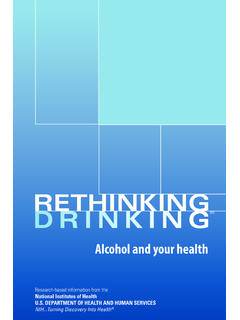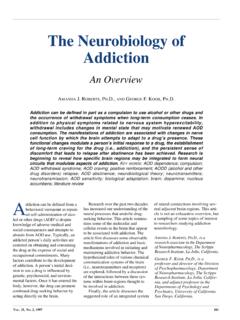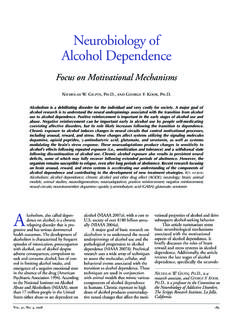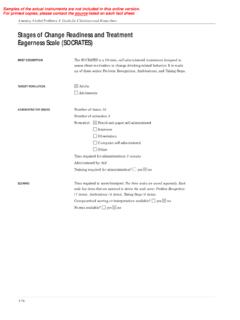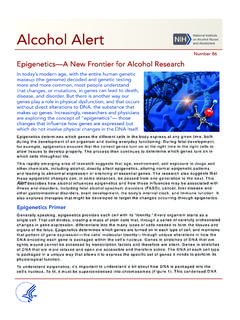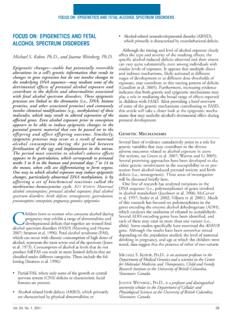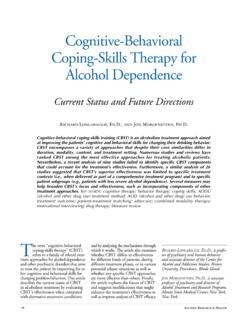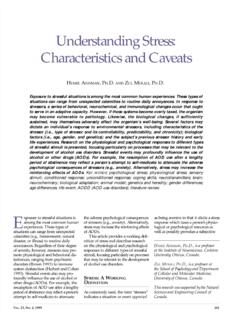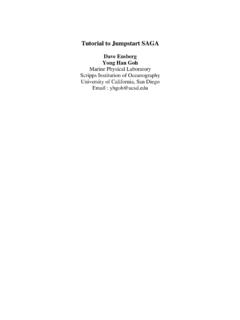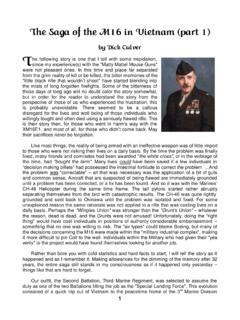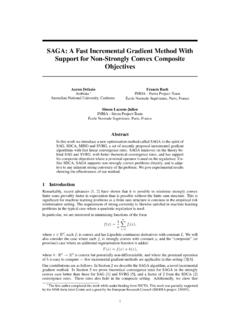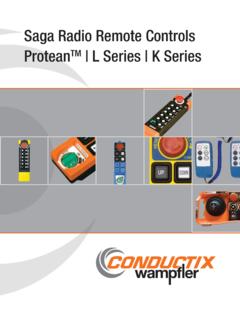Transcription of Semi-Structured Assessment for the Genetics of Alcoholism ...
1 Samples of the actual instruments are not included in this online version. For printed copies, please contact the source listed on each fact sheet. Semi-Structured Assessment for the Genetics of Alcoholism (SSAGA-II) Semi-Structured Assessment for the Genetics of Alcoholism (SSAGA-II) BRIEF DESCRIPTION TARGET POPULATION The SSAGA-II was designed to assess the physical, psychological, and social manifestations of alcohol abuse or dependence and other psychiatric disorders. It is is a polydiagnostic instrument that assesses somatization disorder, alcohol, nicotine, marijuana and drug abuse/dependence, anorexia, bulimia, adult attention-deficit/hyperactivity disorder, depression, mania, dysthymia, antisocial personality disorder, posttraumatic stress disorder, panic, agoraphobia, social phobia, and obsessive-compulsive disorder using DSM-III-R and DSM-IV and at least one other of the following diagnostic systems: Feighner RDC (Research Diagnostic Criteria), and ICD-10.
2 Many disorders can be scored for DSM-III diagnosis as well. The SSAGA-II also covers general demographic information, medical history information, information about tobacco use, and suicide attempts, and it contains a psychosis screener to identify individuals requiring clinical followup for diagnosis. The SSAGA has the interviewer plot a life chart of diagnoses to elaborate on comorbidity, the course of the respondent s substance use as this relates to other psychiatric problems. A specification manual has been written for the SSAGA to clarify items, and in cases where paraphrasing is necessary, so that the interviewer is aware of the intent of a specific question. The manual gives a general overview of the instrument, including coding principles and conventions. Adults Adolescents (over 16 years) Groups for which this instrument might be especially helpful? Companion interviews include the C-SSAGA-C (for children ages 7 to 12), the C-SSAGA-A (for adolescents ages 13 to 17) and a parent interview (the C-SSAGA-P).
3 565 _____Assessing Alcohol Problems: A Guide for Clinicians and Researchers ADMINISTRATIVE ISSUES Number of items: 45 multipart Number of subscales: Format(s): Pencil-and-paper self-administered Interview ( structured ) Observation Computer self-administered Other Time required for administration: Depends on psychopathology present: 45 minutes for unaffected individual, up to 4 hours for extremely affected individuals Administered by: structured interview by nonclinician with review by clinician Training required for administration? yes no Comments: Interviewer training of 1 week required. SCORING Time required to score/interpret: Hand scoring of alcohol section using DSM-IV should take 5 to 7 minutes Scored by: Interviewer Scoring key? yes no Computerized scoring or interpretation available? yes no Norms available? yes no Instrument normed on subgroups? yes no PSYCHOMETRICS Have reliability studies been done? yes no What measure(s) of reliability was used?
4 Test-retest Split half Interrater Have validity studies been done? yes no What measures of validity have been derived? Content Criterion (predictive, concurrent, postdictive ) Construct 566 Semi-Structured Assessment for the Genetics of Alcoholism (SSAGA-II) CLINICAL UTILITY OF INSTRUMENT RESEARCH APPLICABILITY SOURCE, COST AND COPYRIGHT ISSUES SOURCE REFERENCES SUPPORTING REFERENCE The SSAGA-II has been specifically designed to study, in detail, Alcoholism and associated comorbid psychiatric diagnoses. Both current status ( , recency of problems) and lifetime ( , age of onset of problems and conditions) status are assessed. The age of onset and the age of recency of problems are obtained throughout the interview. Ideally, patterns of use and frequencies of specific symptoms will identify potential problem areas to target for prevention/intervention efforts. However, SSAGA-II as a diagnostic instrument was not designed with a treatment focus in mind.
5 SSAGA-II can subtype Alcoholism with comorbid conditions (drug abuse/dependence, major depression, and antisocial personality disorder) to act as a guide in treatment matching, substance counseling, family counseling, etc. The questions in SSAGA-II may help unaffected individuals understand some of the difficulties that may result when alcohol/substance abuse or dependence has occurred. The SSAGA is a polydiagnostic interview (DSM-III-R, DSM-IV, ICD-10) with an emphasis on substance use and co-related diagnoses. It assesses common psychiatric disorders prevalent in a general population, and occurring with greater frequency in alcoholics and substance abusers and their families. Special attention is paid to the interrelationship of substance use and psy chiatric diagnoses. Because SSAGA-II is a comprehensive interview, it could be used in other types of studies where substance abuse is common, but is not necessarily the main focus of the study. Copyright: yes no Cost: Public domain Source: Copies of the SSAGA may be obtained from: Victor Hesselbrock, Department of Psychiatry, MC-2103 University of Connecticut, School of Medicine Farmington, CT 06030-2103 E-mail: Hesselbrock, M.
6 , Easton, C., Bucholz, , Schuckit, M. & Hesselbrock, V. (1999). A validity study of the SSAGA a comparison with the SCAN. Addiction, 94(9), 1361-1370. Bucholz, , Cadoret, R., Cloninger, , et al. (1994). Semi-Structured psychiatric interview for use in genetic linkage studies: A report on the reliability for the SSAGA. Journal of Studies on Alcohol, 55(2), 149-158. Schuckit, , Anthinelli, , Bucholz, , et al. (1995). Time course of development of alcohol-related problems in men and women. Journal of Studies on Alcohol, 56(2), 218-225. 567
